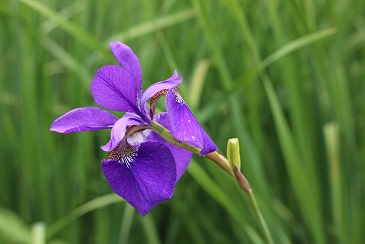Learn how to Grow, Propagate and Care for Irises
This
is a valuable course for anyone with a serious interest in irises
either as a commercial grower or an enthusiastic home collector. You
will gain an in-depth appreciation of the iris, how to grow them to
achieve optimum results and the identification of different varieties of
irises. Significant sections are included on landscaping with irises,
hybridisation and propagation, harvest, post-harvest treatments,
achieving and assessing quality, and exhibiting the flowers.

COURSE STRUCTURE
There are 8 lessons as follows:
- Introduction
- Review of the system of plant identification
- Physiology
- Information sources
- Culture
- Planting
- Staking
- Mulching
- Watering
- Feeding
- Pruning, etc.
- Propagation and Hybridisation
- Review of Major Types of Irises
- Pest and Diseases
- Irrigation and Hydroponics
- Landscaping with Irises
- Harvest, Post Harvest, Exhibiting and Quality
Each lesson culminates in an assignment which is submitted to the
school, marked by the school's tutors and returned to you with any
relevant suggestions, comments, and if necessary, extra reading.
Duration: 100 hours
 Learn about the Diversity of Irises
Learn about the Diversity of Irises
There are many different types of iris in cultivation. Some grow submerged in water while bothers can be quite tolerant of dry soils. Some tolerate heat or cold better than others, and the size of both the plants and flowers can also vary greatly. Irises originate from a very a wide variety of climates and soil types. There is no “ideal” location for “all” irises.
Consider:
- Irises occur naturally in both sub arctic and sub tropical climates
- Irises can be found growing naturally at very high altitudes above the snow line, and also close to sea level.
- There are iris species that are native to deserts, and other species that are native to swamps.
- There are species which must have very well drained and dry soil at least part of the year, and others that need soil rich in humus and saturated with water.
- Some grow in alkaline soils, while others will die if the soil is not acidic.
If you are going to select the right iris for the right position, you need to get to know the differences between species and cultivars, and understand the factors that characterise the places you wish to grow them.
Iris species and cultivars can be found that will suit a very diverse range of situations.
- Some irises prefer very wet soil, and others tolerate or even need dry conditions. For those, roots may rot and the plant could die if the soil becomes wet at the wrong time of the year.
- Some irises love a hot soil, while others need to have the roots always kept moist and cool
- Some tolerate snow or even frozen ground, and others don’t.
- Some do best in shade, while others must have full sun.